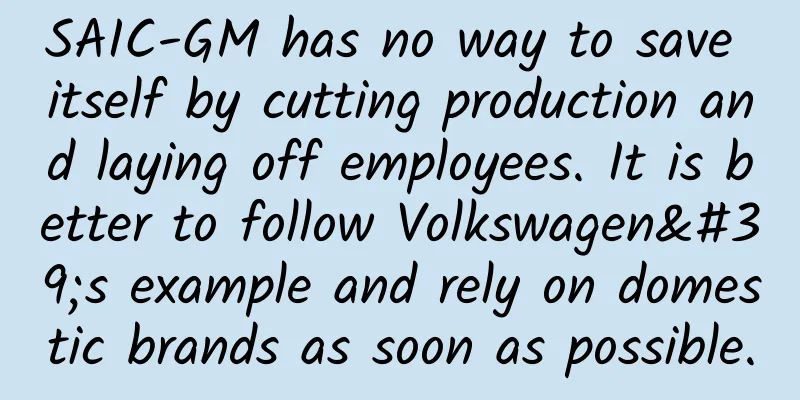SAIC-GM has no way to save itself by cutting production and laying off employees. It is better to follow Volkswagen's example and rely on domestic brands as soon as possible.

|
Toyota, Honda, and Nissan all fell in price. Japanese cars are no longer doing well. Do you often hear such discussions? But is it possible that a sharp drop in sales can still attract attention, proving that the brand still has some influence? Those brands that no one pays attention to no matter how much their sales drop are the ones that are truly "dead". Recently there have been reports that General Motors is cutting staff in many departments, including R&D, and will discuss production cuts with SAIC in the coming weeks. This may be the biggest wave of traffic that GM has created in the domestic auto market in recent months. In fact, this representative manufacturer of American cars is having a much worse time than Japanese cars. Sales data showed that the cumulative sales of SAIC-GM's three major brands, Buick, Cadillac and Chevrolet, were only 15,000 vehicles in July, down 82.42% year-on-year; from January to July this year, SAIC-GM's cumulative sales were 240,579 vehicles, down 55.14% year-on-year. This decline is much more serious than that of Japanese cars, but SAIC-GM's sales volume is relatively small and there are not many new cars, so it has not caused enough discussion like Japanese cars. Three brands, seven months, a total of 240,000 vehicles sold, what is the level in the current Chinese market? Take Ideal Auto as an analogy, the average selling price of its five main models is much higher than that of SAIC-GM, and the cumulative sales volume from January to July was 231,000 vehicles. Is it unfair that GM has fallen to this point? No, at least judging from the sales distribution of its models, it is a true portrayal of eating up all the resources. In July 2024, Buick's best-selling model was Buick GL8, with monthly sales of more than 8,000 units; followed by Buick Regal, with monthly sales of 4,807 units; there were 11 models on sale, and only 4 had monthly sales of more than 3,000 units. Chevrolet's sales champion is the Cruze, with sales of 2,601 units. Among other models, the one with the highest sales is the Equinox Plus, with sales of 289 units. The best-selling model under Cadillac is the Cadillac CT5, with monthly sales of only 3,796 units; the second is the Cadillac XT5, with monthly sales of only 2,161 units. The sales of other models are all below 600 units. To sum it up simply, SAIC-GM has three major brands and nearly 30 models, each of which is "old-fashioned". The only one that can really enter the mainstream market is the Buick GL8. Even with such a good performance, it is the result of a significant price cut. For example, the Cadillac CT5 has an official guide price of 289,700 yuan, but the actual starting price is just over 200,000 yuan. In the field of new energy, SAIC-GM is also in a bleak situation. The only products it can show off are Buick Velite 6 and Buick GL8 plug-in hybrid. The former achieved sales of 2,898 units in July thanks to its low-end positioning; the latter relied on its plug-in hybrid system to attract people and became the "hope of the entire factory." Cadillac has two new energy vehicle models built on the AutoNergy platform, namely IQ Aoge and IQ Ruige, which sold a total of 438 units in July; as for Chevrolet, it has simply remained flat in the new energy field and has not launched any new energy vehicle models on the market so far. SAIC-GM's performance is no longer like a mainstream brand, but is closer to the Korean and French cars that suffered a sharp decline a few years ago. You should know that in 2017, SAIC-GM's annual sales in China were close to 2 million vehicles (excluding Wuling). Seven years later, it was only 1 million vehicles last year. At the current rate, it may not even have 500,000 vehicles this year. The natural result of declining sales is continued losses. In the first half of 2024, General Motors' losses in China reached 210 million US dollars, which does not sound like much, but when you think about it, just a few years ago, the Chinese market was still General Motors' cash cow, contributing billions of profits every year. In contrast, one can't help but think of a word - sad and miserable. It is in this situation that layoffs become a necessary option. Although major manufacturers like to use rhetoric such as "optimizing processes" and "strengthening the supply chain" to replace the word "layoffs", layoffs are layoffs. This is the first killer weapon that every manufacturer takes out of the "toolbox" when encountering a crisis. In fact, as early as May this year, rumors began to circulate on the Internet that SAIC-GM would use the "high temperature holiday" method to achieve a 2-3 month production suspension. There was even news that SAIC-GM would complete a 30% layoff this year, but it was later denied by SAIC-GM officials. The latest rumor was also denied by SAIC-GM, but the tone was much softer. GM China responded that its partnership with SAIC and its commitment to promoting the long-term development of the joint venture have not changed, and it will continue to provide the best products and technologies for Chinese consumers. When something becomes an open secret, it is meaningless to cover it up or deny it, because covering up is existence and denial is the truth. SAIC-GM's total production line capacity was designed based on the peak sales in 2017, which was about 1.908 million vehicles. However, SAIC-GM's sales in 2023 were only 1.001 million vehicles, and the utilization rate was only 53%, which may fall to around 25% this year. How to save GM? If GM wants to stay in the Chinese market, electric vehicles are the only choice. According to SAIC-GM's product plan, the company will launch more than 10 new energy vehicle models based on the Autoneng platform in 2025; at the same time, it will also establish an automotive software and digital center. Today is already late August 2024. Based on SAIC-GM's speed in launching new cars, it is estimated that the plan to launch 10 new energy vehicles in 2025 is basically impossible to achieve. As for the establishment of an automotive software and digitalization center, it is enough to just listen to it. For traditional car companies to develop new businesses, it is estimated that it will take three to five years just to tear down department walls, not to mention that this will directly destroy the jobs of many "colleagues". If you don't believe it, just look at Volkswagen next door. It also wanted to do this, but later it went around in circles and spent billions of euros, but it still joined hands with Xiaopeng and completely stopped playing. There are already many cases of Sino-foreign joint ventures where China provides the technology and foreign countries provide the capital, and General Motors can just use them directly. Hundreds of automotive engineers from Volkswagen have entered Xiaopeng Motors' headquarters, and after only one year of cooperation, the two sides have progressed to the stage of jointly developing electronic and electrical architecture. The first batch of electric vehicles jointly produced by Stellantis and Leapmotor have been shipped to Europe and are on sale. The two parties only started their cooperation at the end of last year, and it has been less than a year since then. Recently, there has been news in the market that Audi will adopt Huawei's intelligent driving system. In fact, even Tesla, which is also an American car, is also an excellent student in cooperation with China. Since the start of construction of the Shanghai Super Factory, Tesla has been continuously purchasing core components from China, and the current localization rate has exceeded 95%. It is obvious that if SAIC-GM wants to get out of its predicament through new energy, it must, like other foreign manufacturers, obtain technical support from Chinese manufacturers and rely on the Chinese supply chain to build products, rather than being obsessed with its own little piece of land and so-called face. The automobile industry is a global industry with a high degree of specialization. Automobile manufacturers should go to where the technology is advanced and the parts are powerful. Volkswagen and Tesla can figure this out, and SAIC-GM should also be able to figure this out. It is worth mentioning that General Motors and SAIC signed a 30-year cooperation agreement, which will expire in 2027, and it is now the second half of 2024. To quote a classic line: Time is running out for SAIC-GM. As a winner of Toutiao's Qingyun Plan and Baijiahao's Bai+ Plan, the 2019 Baidu Digital Author of the Year, the Baijiahao's Most Popular Author in the Technology Field, the 2019 Sogou Technology and Culture Author, and the 2021 Baijiahao Quarterly Influential Creator, he has won many awards, including the 2013 Sohu Best Industry Media Person, the 2015 China New Media Entrepreneurship Competition Beijing Third Place, the 2015 Guangmang Experience Award, the 2015 China New Media Entrepreneurship Competition Finals Third Place, and the 2018 Baidu Dynamic Annual Powerful Celebrity. |
Recommend
Nine blogs to watch for hybrid mobile app developers
[51CTO.com Quick Translation] The rapid populariz...
After 6 years, the first perfect jailbreak of iOS 14 is released: supports iPhone 12
[[431010]] Since the perfect jailbreak in the iOS...
How much does it cost to invest in Shaoxing’s automatic ordering app? What is the investment price for Shaoxing’s automatic ordering app?
How much does it cost to invest in the automatic ...
What is Touch Bar? 13-inch Touch Bar version of MBP disassembled
On November 17, the famous foreign disassembly te...
About Android strings.xml - Several principles you should know
[[187865]] Don't try to reuse Do not reuse a ...
How much does a piece of Cordyceps sinensis cost in 2020?
How much does a piece of Cordyceps sinensis cost ...
Summary of search function design, designers please take a look
In the previous articles, I mentioned that if des...
Advertising strategies of Xiaohongshu and Bilibili
Without further ado, let’s get straight to the po...
Douyin short video sales tutorial, earning 100,000 yuan a month is not a legend
Douyin short video sales tutorial, earning 100,00...
How to use SMS to attract and recall lost users?
There are three common methods of user recall or ...
Mobile Internet is back! WeChat has changed: You can also browse Moments on PC
In the past year, the development of mobile Inter...
What are the “menstrual-like” hot spots in Beijing, Shanghai and Guangzhou?
In this article, Li Jiaoshou analyzes: After chan...
Zhu Guomiao postpartum recovery
Zhu Guomiao's postpartum rehabilitation resou...
World Food Day: Chinese grain brings a sense of security to the Chinese people
Jointly produced by: People's Daily Weibo x D...
Chang'e 6 is launched today! Reviewing Chang'e's 17-year lunar exploration feat!
On May 1, the National Space Administration relea...









